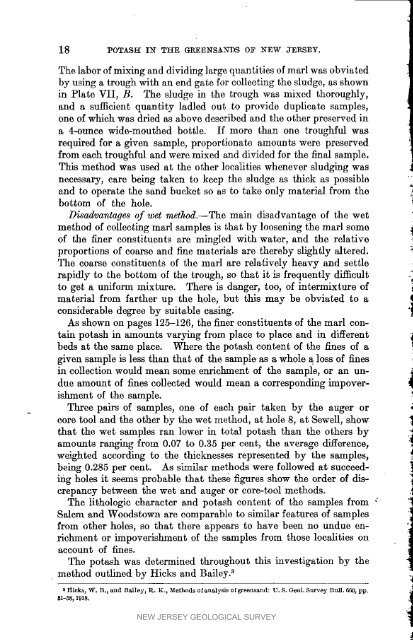Bulletin 23. Potash in the Greensands of NJ, 1923 - State of New ...
Bulletin 23. Potash in the Greensands of NJ, 1923 - State of New ...
Bulletin 23. Potash in the Greensands of NJ, 1923 - State of New ...
You also want an ePaper? Increase the reach of your titles
YUMPU automatically turns print PDFs into web optimized ePapers that Google loves.
18 POTASH IN THE GREENSA_NTDS OF NEW ;YERSEY.<br />
The labor <strong>of</strong> mix<strong>in</strong>g and divid<strong>in</strong>g large quantities <strong>of</strong> marl was obviated<br />
by us<strong>in</strong>g a trough with an end gate for collect<strong>in</strong>g <strong>the</strong> sludge, as shown<br />
<strong>in</strong> Plate VII, B. The sludge <strong>in</strong> <strong>the</strong> trough was mixed thoroughly,<br />
and a sufficient quantity ladled out to provide duplicate samples,<br />
one <strong>of</strong> which was dried as above described and <strong>the</strong> o<strong>the</strong>r preserved <strong>in</strong><br />
a 4-ounce wide-mou<strong>the</strong>d bottle. If more than one troughful was<br />
required for a given sample, proportionate amounts were preserved<br />
from each troughful and were mixed and divided for <strong>the</strong> f<strong>in</strong>al sample.<br />
This method was used at <strong>the</strong> o<strong>the</strong>r localities whenever sludg<strong>in</strong>g was<br />
necessary, care be<strong>in</strong>g taken to keep <strong>the</strong> sludge as thick as possible<br />
and to operate <strong>the</strong> sand bucket so as to take only material from <strong>the</strong><br />
bottom <strong>of</strong> <strong>the</strong> hole. "<br />
Disadvantages <strong>of</strong> wet method.--The ma<strong>in</strong> disadvantage <strong>of</strong> <strong>the</strong> wet<br />
method <strong>of</strong> collect<strong>in</strong>g marl samples is that by loosen<strong>in</strong>g <strong>the</strong> marl some i<br />
<strong>of</strong> <strong>the</strong> f<strong>in</strong>er constituents are m<strong>in</strong>gled with water, and <strong>the</strong> relative<br />
proportions <strong>of</strong> coarse and f<strong>in</strong>e materials are <strong>the</strong>reby slightly altered.<br />
The coarse constituents <strong>of</strong> <strong>the</strong> marl are relatively heavy and settle<br />
rapidly to <strong>the</strong> bottom <strong>of</strong> <strong>the</strong> trough, so that it is frequently difficult -<br />
to get a uniform mixture. There is danger, too, <strong>of</strong> <strong>in</strong>termixture <strong>of</strong><br />
material from far<strong>the</strong>r up <strong>the</strong> hole, but this may be obviated to a<br />
considerable degree by suitable cas<strong>in</strong>g. J<br />
As shown on pages 125-126, <strong>the</strong> f<strong>in</strong>er constituents <strong>of</strong> <strong>the</strong> marl conra<strong>in</strong><br />
beds<br />
potash<br />
at <strong>the</strong> same<br />
<strong>in</strong> amounts<br />
place.<br />
vary<strong>in</strong>g<br />
Where<br />
from<br />
<strong>the</strong> potash<br />
place to<br />
content<br />
place<br />
<strong>of</strong><br />
and<br />
<strong>the</strong><br />
<strong>in</strong><br />
f<strong>in</strong>es<br />
different<br />
<strong>of</strong> a<br />
i<br />
given sample is less than that <strong>of</strong> <strong>the</strong> sample as a whole a loss <strong>of</strong> f<strong>in</strong>es<br />
<strong>in</strong> collection would mean some enrichment <strong>of</strong> <strong>the</strong> sample, or an undue<br />
amount <strong>of</strong> f<strong>in</strong>es collected would mean a correspond<strong>in</strong>g impoverishment<br />
<strong>of</strong> <strong>the</strong> sample.<br />
Three pairs <strong>of</strong> samples, one <strong>of</strong> each pair taken by <strong>the</strong> auger or<br />
core tool and <strong>the</strong> o<strong>the</strong>r by <strong>the</strong> wet method, at hole 8, at Sewell, show<br />
that <strong>the</strong> wet samples ran lower <strong>in</strong> total potash than <strong>the</strong> o<strong>the</strong>rs by<br />
amounts rang<strong>in</strong>g from 0.07 to 0.35 per cent, <strong>the</strong> average difference,<br />
weighted accord<strong>in</strong>g to <strong>the</strong> thicknesses represented by <strong>the</strong> samples,<br />
be<strong>in</strong>g 0.285 per cent. As similar methods were followed at succeed<strong>in</strong>g<br />
holes it seems probable that <strong>the</strong>se figures show <strong>the</strong> order <strong>of</strong> discrepancy<br />
between <strong>the</strong> wet and auger or core-tool methods.<br />
The lithologic character and potash content <strong>of</strong> <strong>the</strong> samples from :<br />
Salem and Woodstown are comparable to similar features <strong>of</strong> samples<br />
from o<strong>the</strong>r holes, so that <strong>the</strong>re appears to have been no undue enrichment<br />
or impoverishment <strong>of</strong> <strong>the</strong> samples from those localities on<br />
account <strong>of</strong> f<strong>in</strong>es.<br />
The potash was determ<strong>in</strong>ed throughout this <strong>in</strong>vestigation by <strong>the</strong><br />
• method outl<strong>in</strong>ed by Hicks and Bailey. a<br />
* Hicks_ W. B._ and Bailey t R. K,, Methods o f analysis o f greens_d: U. S. Geol. Survey Bull. fifO, pp.<br />
51-58_ 1918.<br />
NEW JERSEY GEOLOGICAL SURVEY<br />
4

















